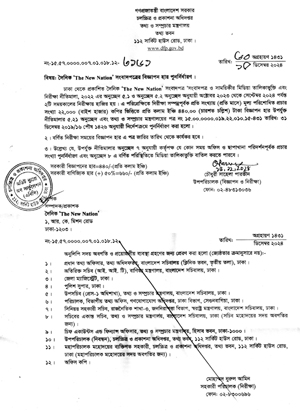Staff Reporter :
An earthquake measuring 4.0 on the Richter scale jolted Dhaka and several other parts of Bangladesh on Friday afternoon, raising renewed concerns over the country’s seismic vulnerability.
The tremor occurred within just 15 days of the powerful earthquakes that recently devastated parts of Myanmar and Thailand-regions that share the same seismic zone as Bangladesh.
According to the Earthquake Observation and Research Centre under the Meteorological Department, the epicentre was located near the Bangladesh-India border, close to Brahmanbaria and Habiganj.
Md Rubaiyyat Kabir, Acting Officer at the centre, confirmed that the moderate quake occurred at approximately 4:52pm.
Despite the absence of reported damage, experts say the tremor highlights the urgent need for improved earthquake preparedness across the country.
Professor Humayun Akhter, a renowned earthquake specialist and former faculty member at the Department of Geology, University of Dhaka, reiterated that the epicentre was situated along the border region.
The latest seismic event follows a catastrophic double quake in Myanmar on 28 March, where earthquakes measuring 7.7 and 6.4 struck near Sagaing city in Mandalay within a span of 12 minutes, resulting in the loss of over 3,500 lives.
Experts warn that Bangladesh’s own vulnerabilities – such as high population density, unplanned urban growth, and inadequate structural resilience – could lead to similar devastation in the event of a major quake.
Authorities and experts have emphasised the importance of adhering strictly to building codes to mitigate the impact of future earthquakes.
All new constructions, particularly in urban centres, must comply with earthquake-resistant standards. Meanwhile, older, structurally unsound buildings should either be retrofitted or dismantled to minimise risk.
“If a large-scale earthquake occurs in Bangladesh, the consequences would be catastrophic,” said Dr Subrota Kumar Saha, Professor and Chair of the Department of Geology at Dhaka University.
“We lack sufficient open spaces for evacuation, our utility systems including gas pipelines are disorganised, and many buildings are constructed on soft flood plains.”
Dr Saha also warned of the risks associated with earthquakes in the Chattogram Hill Tracts, where seismic activity could trigger deadly landslides.
“We are inadequately prepared for post-earthquake disaster management,” added Dr Md Bodruddoza Mia, Professor at the Department of Geology, Dhaka University.
“Despite repeated tremors, we lack comprehensive seismic studies and real-time insights into the possibility of a major quake. The last devastating Bengal earthquake occurred over a century ago.”
Experts unanimously stress the importance of conducting regular earthquake drills across schools, hospitals, workplaces, and residential areas. Such drills can familiarise the public with safety procedures and help reduce panic during actual seismic events.
The installation of nationwide seismic monitoring and early warning systems is deemed critical. These systems can provide crucial seconds or minutes of advance notice, enabling both citizens and emergency services to respond effectively.
In addition, a large-scale public awareness campaign is needed to educate communities on earthquake safety. Community-level training programmes should be introduced to ensure that all citizens are equipped with essential knowledge and skills for earthquake response.
Local emergency response teams must also be adequately trained and resourced, particularly in high-risk areas. Their role will be vital in the immediate aftermath of a disaster, providing emergency aid and coordinating rescue operations.
Bangladesh has the opportunity to learn from earthquake-prone countries such as Japan, Chile, and Nepal, all of which have developed robust preparedness systems following devastating quakes. The adoption of international best practices could greatly enhance national resilience.
While Friday’s tremor resulted in no serious damage, it serves as a stark reminder of what could happen if the country fails to act. The tragedy in Myanmar underscores how quickly lives can be lost in the absence of proper preparation and infrastructure.


